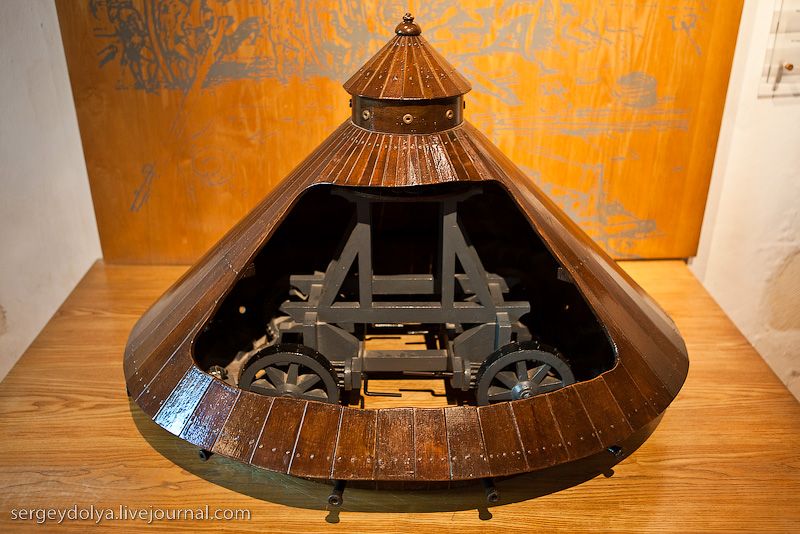|
|
Leonardo Da Vinci Castle
|
• Advent of gunpowder
Artillery powered by gunpowder was introduced to Europe in the 1320s and spread quickly. Handguns, which were initially unpredictable and inaccurate weapons, were not recorded until the 1380s. Castles were adapted to allow small artillery pieces – averaging between 19.6 and 22 kg (43 and 49 lb) – to fire from towers. These guns were too heavy for a man to carry and fire, but if he supported the butt end and rested the muzzle on the edge of the gun port he could fire the weapon. The gun ports developed in this period show a unique feature, that of a horizontal timber across the opening. A hook on the end of the gun could be latched over the timber so the gunner did not have to take the full recoil of the weapon. This adaptation is found across Europe, and although the timber rarely survives, there is an intact example at Castle Doornenburg in the Netherlands. Gunports were keyhole shaped, with a circular hole at the bottom for the weapon and a narrow slit on top to allow the gunner to aim. This form is very common in castles adapted for guns, found in Egypt, Italy, Scotland, and Spain, and elsewhere in between. Other types of port, though less common, were horizontal slits – allowing only lateral movement – and large square openings, which allowed greater movement. The use of guns for defence gave rise to artillery castles, such as that of Château de Ham in France. Defences against guns were not developed until a later stage. Ham is an example of the trend for new castles to dispense with earlier features such as machicolations, tall towers, and crenellations.
Bigger guns were developed, and in the 15th century became an alternative to siege engines such as the trebuchet. The benefits of large guns over trebuchets – the most effective siege engine of the Middle Ages before the advent of gunpowder – were those of a greater range and power. In an effort to make them more effective, guns were made ever bigger, although this hampered their ability to reach remote castles. By the 1450s guns were the preferred siege weapon, and their effectiveness was demonstrated by Mehmed II at the Fall of Constantinople. The response towards more effective cannons was to build thicker walls and to prefer round towers, as the curving sides were more likely to deflect a shot than a flat surface. While this sufficed for new castles, pre-existing structures had to find a way to cope with being battered by cannon. An earthen bank could be piled behind a castle's curtain wall to absorb some of the shock of impact. Often, castles constructed before the age of gunpowder were incapable of using guns as their wall-walks were too narrow. A solution to this was to pull down the top of a tower and to fill the lower part with the rubble to provide a surface for the guns to fire from. Lowering the defences in this way had the effect of making them easier to scale with ladders. A more popular alternative defence, which avoided damaging the castle, was to establish bulwarks beyond the castle's defences. These could be built from earth or stone and were used to mount weapons.
Around 1500, the innovation of the angled bastion was developed in Italy. With developments such as these, Italy pioneered permanent artillery fortifications, which took over from the defensive role of castles. From this evolved star forts, also known as trace italienne. The elite responsible for castle construction had to choose between the new type that could withstand cannon-fire and the earlier, more elaborate style. The first was ugly and uncomfortable and the latter was less secure, although it did offer greater aesthetic appeal and value as a status symbol. The second choice proved to be more popular as it became apparent that there was little point in trying to make the site genuinely defensible in the face of cannon. For a variety of reasons, not least of which is that many castles have no recorded history, there is no firm number of castles built in the medieval period. However, it has been estimated that between 75,000 and 100,000 were built in western Europe; of these around 1,700 were in England and Wales and around 14,000 in German-speaking areas.
|
|









